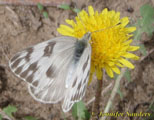Native Plants
Search for native plants by scientific name, common name or family. If you are not sure what you are looking for, try the Combination Search or our Recommended Species lists.
Peritoma serrulata
Peritoma serrulata (Pursh) de Candolle
Rocky Mountain Bee-plant, Stinking-clover, Bee Spiderflower, Navajo Spinach, Pink Cleome, Toothed Spiderflower, Skunkweed
Capparaceae (Caper Family)
Synonym(s): Cleome serrulata
USDA Symbol: PESE7
USDA Native Status: L48 (N)
"Annuals, 30-80 cm. Stems sparsely branched; glabrous or glabrate. Leaves: (stipules bristlelike), petiole 1.5-3.5 cm; leaflets 3, blade elliptic, 2-6 × 0.6-1.5 cm, margins entire, weakly sinuate, or serrulate, apex acute, long-acuminate, or mucronate, surfaces glabrate (margins with sparse, relatively long hairs when young). Racemes 1-4 cm (4-30 cm in fruit); bracts unifoliate, obovate, 4-22 mm. Pedicels (green to purple), 8-20 mm. Flowers: sepals persistent, connate 1/2-2/3 of length, purple to green, lanceolate, 1.7-4 × 1-2 mm, margins denticulate, glabrous; petals purple (rarely white), oblong to ovate, 7-12 × 3-6 mm; stamens purple, 18-24 mm; anthers (green), 2-2.3 mm; gynophore 1-15 mm in fruit; ovary 5-7 mm; style 0.1-0.5 mm. Capsules (erect) not inflated, 23-76 × 3-6(-7) mm, striate, (glabrous). Seeds 12-38, black, globose or horseshoe-shaped, 2.8-4 × 2.5-3 mm, rugose. 2n = 34, 60." (Webref: 3).
"Most collections of Peritoma serrulata from the northeastern and midwestern United States apparently represent non-persistent waifs or garden escapes. The species has been cultivated as a source of nectar for honeybees since ca. 1880 (L. H. Bailey 1900-1902). It shows considerable variation in fruit size, even within populations. The variation may reflect environmental influences, especially water availability, rather than genetics (H. H. Iltis 1952)." (Webref: 3). "Not native to California" (Webref: 30).
Plant Characteristics
Duration: AnnualHabit: Herb
Leaf Arrangement: Alternate
Leaf Complexity: Palmate , Trifoliate
Leaf Shape: Elliptic
Leaf Pubescence: Glabrous
Leaf Margin: Entire , Serrulate
Leaf Apex: Acuminate , Acute , Mucronate
Inflorescence: Axillary , Raceme , Terminal
Fruit Type: Capsule
Size Notes: Usually to about 32 in height. Can reach 6 feet in height.
Leaf: "Leaves: (stipules bristlelike), petiole 1.5-3.5 cm; leaflets 3, blade elliptic, 2-6 x 0.6-1.5 cm, margins entire, weakly sinuate, or serrulate, apex acute, long-acuminate, or mucronate, surfaces glabrate (margins with sparse, relatively long hairs when young)." (Webref: 3)
Flower: "Racemes 1-4 cm (4-30 cm in fruit); bracts unifoliate, obovate, 4-22 mm. Pedicels (green to purple), 8-20 mm. Flowers: sepals persistent, connate 1/2-2/3 of length, purple to green, lanceolate, 1.7-4 x 1-2 mm, margins denticulate, glabrous; petals purple (rarely white), oblong to ovate, 7-12 x 3-6 mm; stamens purple, 18-24 mm; anthers (green), 2-2.3 mm; gynophore 1-15 mm in fruit; ovary 5-7 mm; style 0.1-0.5 mm." (Webref: 3)
Fruit: "Capsules (erect) not inflated, 23-76 x 3-6(-7) mm, striate, (glabrous). Seeds 12-38, black, globose or horseshoe-shaped, 2.8-4 x 2.5-3 mm, rugose." (Webref: 3)
Bloom Information
Bloom Color: White , PurpleBloom Time: May , Jun , Jul , Aug , Sep
Bloom Notes: "Petals purple (rarely white)." (Webref: 3).
Distribution
USA: AZ , CA , CO , IA , ID , IL , IN , KS , MA , MI , MN , MO , MT , ND , NE , NM , NV , OH , OK , OR , SD , TX , UT , WA , WYCanada: AB , BC , MB , ON , SK
Native Distribution: "Alberta, British Columbia, Manitoba, Ontario, Saskatchewan; Arizona, California, Colorado, Idaho, Illinois, Indiana, Iowa, Kansas, Massachusetts, Michigan, Minnesota, Missouri, Montana, Nebraska, Nevada, New Mexico, North Dakota, Ohio, Oklahoma, Oregon, South Dakota, Texas, Utah, Washington, Wyoming." (Webref: 3). "Most collections of Peritoma serrulata from the northeastern and midwestern United States apparently represent non-persistent waifs or garden escapes." (Webref: 3).
Native Habitat: "Shortgrass and mixed grass prairies, pastures, pinyon pine and juniper woodland, desert scrub, roadsides, stabilized sand dunes; (100-) 300-2500(-2900) m." (Webref: 3).
Growing Conditions
Water Use: LowLight Requirement: Sun , Shade
Soil Moisture: Dry , Moist
Soil pH: Alkaline (pH>7.2) , Acidic (pH<6.8) , Circumneutral (pH 6.8-7.2)
Drought Tolerance: High
Cold Tolerant: yes
Heat Tolerant: yes
Soil Description: "Most common on well-drained, moist to dry, medium-textured to sandy soils with pH 6 to 7.6, but it also occurs on clay and gravel soils." (Webref: 148).
Conditions Comments: "Not tolerant of waterlogging." (Webref: 148).
Benefit
Use Wildlife: "Seeds of Rocky Mountain beeplant are used by pocket mice (Perognathus longimembris)Conspicuous Flowers: yes
Larval Host: Larval host for the checkered white (Pontia protodice). (Webref: 148).
Nectar Source: yes
Deer Resistant: High
Butterflies and Moths of North America (BAMONA)
|
Checkered White (Pontia protodice)  Larval Host |
Propagation
Propagation Material: SeedsWeb Reference
Webref 30 - Calflora (2018) CalfloraWebref 3 - Flora of North America (2014) Missouri Botanical Garden, St. Louis, MO & Harvard University Herbaria, Cambridge, MA.
Webref 148 - Western forbs: Biology, ecology, and use in restoration - Grays Biscuitroot (2020) Great Basin Fire Science Exchange
Additional resources
USDA: Find Peritoma serrulata in USDA PlantsFNA: Find Peritoma serrulata in the Flora of North America (if available)
Google: Search Google for Peritoma serrulata
Metadata
Record Modified: 2022-08-01Research By: Joseph A. Marcus